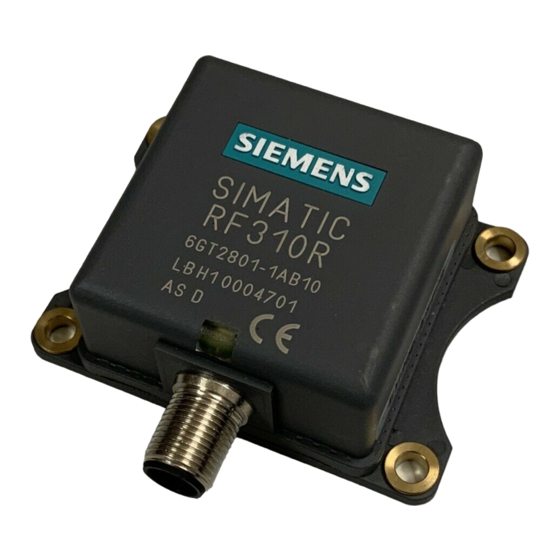
Summarization of Contents
Introduction
Navigating in the System Manual
Explains how to navigate the manual's structure, topics, and organization.
Preface
Details the purpose, scope, and history of the system manual.
Safety Information
Safety Guidelines
Provides notices for personal safety and prevention of property damage, with danger grading.
Repairs
Specifies that repairs must be carried out by authorized qualified personnel.
System Expansion
Advises on installing only approved system expansion devices to avoid damage.
System Overview
RFID Systems
Introduces RFID systems and their general characteristics and applications.
RF300 System Overview
Provides an overview of the SIMATIC RF300 inductive identification system.
Application Areas of RF300
Details primary applications and benefits of the SIMATIC RF300 system.
RFID Components and Their Function
Describes the various components of the RF300 system and their roles.
Technical Data
Lists the technical specifications for the RF300 RFID system.
RF300 System Planning
Fundamentals of Application Planning
Covers essential criteria for selecting RF300 components based on application needs.
Transmission Window and Read/Write Distance
Explains the reader's inductive field and parameters for transmission windows.
Width of the Transmission Window
Details how to determine the transmission window width using an approximation formula.
Impact of Secondary Fields
Discusses the existence and impact of secondary fields in the 0-20mm range.
Permissible Directions of Motion of the Transponder
Illustrates the active area and permissible transponder motion directions.
Operation in Static and Dynamic Mode
Describes transponder operation in static or dynamic modes relative to the reader.
Dwell Time of the Transponder
Explains dwell time and provides a formula for calculation in dynamic mode.
Communication (IQ-Sense Interface)
Details communication between module, reader (IQ-Sense), and transponder.
Calculation Example (IQ-Sense)
Provides an example for calculating maximum user data in dynamic mode.
Communication (RS 422 Interface)
Explains asynchronous communication via RS 422 and data transfer calculations.
Calculation Example (RS 422)
Presents an example calculation for maximum user data using RS 422.
Field Data for Transponders, Readers and Antennas
Provides technical field data for selecting transponders and readers.
Minimum Distances
Specifies minimum distances required between transponders, readers, and antennas.
Data Volume and Transponder Speed Relationship
Illustrates how transponder speed affects data volume for various combinations.
Installation Guidelines
Overview
Outlines points for installation to maintain field data validity.
Reduction of Interference due to Metal
Explains how metal affects operation and provides remedies for interference.
Flush-mounting
Discusses flush-mounting of transponders/readers and measures to counteract window reduction.
Mounting of Several Readers on Metal Frames or Racks
Details mounting readers on metal racks and managing interaction between them.
Effects of Metal on Different Transponders and Readers
Refers to specific descriptions for mounting transponders/readers on metal or flush-mounting.
Impact on the Transmission Window by Metal
Explains how metal affects field data, particularly the transmission window.
Chemical Resistance of Transponders
RF320T and RF360T Resistance
Details chemical resistance for RF320T/RF360T against various substances.
RF340T and RF350T Resistance
Details chemical resistance for RF340T/RF350T against various substances.
EMC Directives
Overview of EMC Guidelines
Answers questions regarding the necessity and prevention of EMC issues.
What Does EMC Mean?
Explains the concept of Electromagnetic Compatibility (EMC).
Basic Rules for EMC
Offers elementary rules for ensuring electromagnetic compatibility (EMC).
Shielding by Enclosure
Discusses using metal enclosures to shield against electromagnetic fields.
Cable Installation Planning
Provides guidelines for planning cable installation to ensure EMC.
Shielding for Cables
Details methods for shielding data and analog cables effectively.
Line and Signal Filter
Advises on using line filters with metal housings for EMC.
Propagation of Electromagnetic Interference
Explains the three components needed for interference to occur.
Interference Sources and Their Effects
Identifies common interference sources and their impact on the system.
Coupling Paths for Interference
Describes the four ways interference can be coupled into a system.
Cabinet Configuration for EMC
Explains how cabinet configuration influences electromagnetic compatibility.













Need help?
Do you have a question about the RF360T and is the answer not in the manual?
Questions and answers